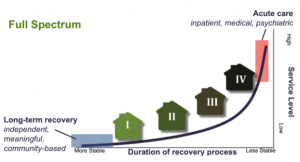Levels of Support
Substance use disorder is a chronic health issue, and individuals seeking recovery have different strengths (recovery capital) and needs, which evolve. In turn, a spectrum of recovery residences has developed across the nation to meet these needs. What exists in a particular marketplace varies based on various factors, including policy barriers and gaps in the local recovery-oriented system of care. In 2011, the National Alliance for Recovery Residences (NARR) established an inclusive framework that defined four different types, known as Levels of Support.
NARR did NOT invent service models, rather the Levels:
- Categorized what already existed in the marketplace.
- Are “big buckets,” meaning much variability exists within each level. Given changing market trends and state laws, “big buckets” allow for diversity, flexibility, and responsiveness in the marketplace while empowering consumer and referral agent choices.
- They are just different choices for different people with additional needs. One Level is not better or more desirable than another.
The embedded graphic shows the Levels of Support plotted within larger continuum care. Note, recovery is a nonlinear process, meaning individuals enter into and move around the spectrum to match evolving needs and levels of support cost-effectively.
individuals enter into and move around the spectrum to match evolving needs and levels of support cost-effectively.
- Level IV RR –Level IVs integrate the social and medical models using supervised peer and professional staff. In addition to peer-based recovery support and life skills development, they offer clinical addiction treatment services. While all Level IVs are licensed treatment, not all licensed treatments are Level IV Recovery Residences. Examples of Level IVs are Extended Aftercare, Therapeutic Communities as well as the “Florida Models” that integrate social model recovery.
- Level III RR –Level IIIs provide weekly, structured programming that includes peer-recovery support services (e.g., recovery and resiliency groups or person-centered recovery planning) and life skills development (e.g., job readiness or budgeting). Staff are supervised, trained or credentialed, and are often graduates of the program. Level IIIs are designed to support people who need extended lengths of support at a higher level of intensity than what Level Is and IIs provide. Level IIIs go by various names. They can be licensed or unlicensed, depending on state laws.
- Level II RR –Level IIs, often called sober homes or sober living, are alcohol- and drug-free recovery housing that use house standards, rules, and peer accountability to maintain safe, healthy, and structured living environments. Senior residents are often appointed as the head of the household, frequently called the House Manager. To serve higher need populations, such as transitional-aged youth with opioid use disorders, some Level IIIs have begun to add person-centered support and life skills development without the service intensity and staffing structure of Level IIIs.
- Level I RR – Level Is are democratically run. The residents elect Officers and vote on decisions. Oxford House TM is the most recognized Level I.
Table of Contents
| Levels Overview | ||
| Level Delineation | ||
| Multiple Criteria |
